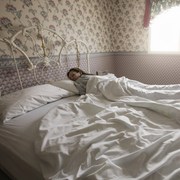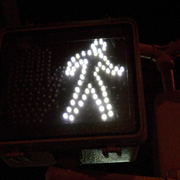 Design Pics/PhotoSpin
Design Pics/PhotoSpin
When you think of sleepwalking, you might picture a child who has climbed out of bed in the middle of the night, sound asleep.
Plenty of children are doing this but it turns out that many teens and even adults are making the midnight circuit in their sleep.
A June 11, 2010 article on ScienceDaily.com said that sleepwalking tends to decrease once childhood has been left behind for the teen years. And those teenagers who are walking in their sleep often have stopped doing so in adulthood.
Research from the University of Arizona in Tucson, Ariz. studied a group of children between 6 and 11 years of age in the Tucson Children's Assessment of Sleep Apnea Study (TuCASA), and revisited them after an average of 4.6 years.
It was found that 27 percent of those who were sleepwalking in childhood were still sleepwalking in adolesence.
Research received funding from the National Heart, Lung, and Blood Institute of the National Institutes of Health.
Another article on ScienceDaily.com from May 14, 2012 reported on research from Stanford University School of Medicine which saw that 3.6 percent of American adults are sleepwalking.
These results were unexpected. Researchers said that adults who sleepwalk are more numerous than it had been thought.
Maurice Ohayon, MD, DSc, PhD, professor of psychiatry and behavioral sciences led the research team. The team said that studies on this behavior have been few, the most recent study before this one having been performed 10 years previously in Europe.
Little data on American adults walking in their sleep is available, and what little there is was first published 30 years ago.
The Stanford University School of Medicine study also found that adults who were depressed were sleepwalking 3.5 times more than those who were not depressed.
People dealing with alcohol dependency or obsessive-compulsive disorder, or who were taking SSRI antidepressants were seen to have a higher incidence of sleepwalking.
A more complete of the person prone to sleepwalking has developed as a result of this research.
Adults who are sleepwalking tend to be chronic sleepwalkers. More than 80 percent of those studied said they have been walking in their sleep for longer than five years.
Sleepwalking was seen to have a tendency to run in the family for almost a third of people studied.
Over-the-counter sleeping pills seem to play a role in many cases of people sleepwalking at least twice in a month.
Sleepwalking is no respecter of genders, seeming to affect a similar number of men and women. In general, as adults get older they do become less likely to sleepwalk.
Sources:
Childhood Parasomnias such as Sleepwalking and Bedwetting Persist into Adolescence. ScienceDaily.com. Retrieved Sept. 6, 2012.
http://www.sciencedaily.com/releases/2010/06/100607065712.htm
Sleepwalking More Prevalent Among U.S. Adults Than Previously Suspected, Researcher Says. ScienceDaily.com. Retrieved Sept. 6, 2012.
http://www.sciencedaily.com/releases/2012/05/120514161614.htm
Visit Jody's website and blog at http://www.ncubator.ca and http://ncubator.ca/blogger
Reviewed September 7, 2012
by Michele Blacksberg RN



Add a CommentComments
There are no comments yet. Be the first one and get the conversation started!